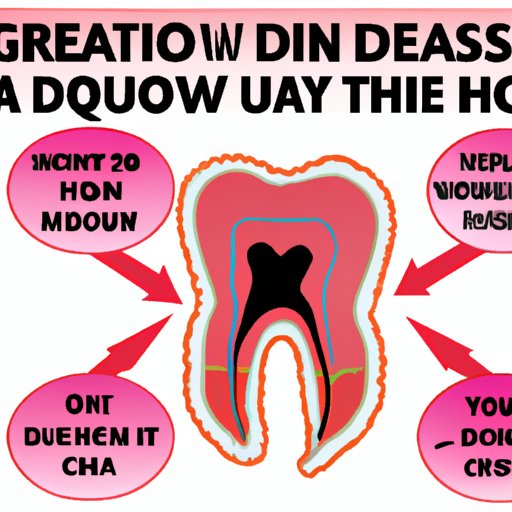
Introduction
Oral health is important for our overall well-being. It not only helps us chew and speak but also affects our mental and physical health. Gum disease, one of the most common oral health issues, can have serious effects on our health if left untreated. This article will help you identify and prevent gum disease, one of the most common health issues worldwide.
Symptom-based approach
Gum disease has various symptoms, and it’s important to identify them early to prevent further damage. The most common symptoms are red, swollen, or bleeding gums, bad breath, and tooth sensitivity or pain. If you experience any of these symptoms, it’s important to seek help and prevent further damage.
Red, swollen, or bleeding gums are some of the most common symptoms of gum disease. They’re a result of inflammation caused by bacteria that form in the crevices between the gums and teeth. If left untreated, this inflammation can lead to bone and tooth loss, making it harder for the tooth to stay in place, causing pain and eventually, tooth loss.
Bad breath also indicates the presence of harmful bacteria in the oral cavity. Gum disease causes an accumulation of bacteria, which gives off a foul smell when it grows in numbers.
Tooth sensitivity or pain is another symptom of gum disease. As bone and tooth structure weaken due to gum disease, the tooth becomes more sensitive to hot or cold liquids and food. This sensitivity occurs because the gum tissues around the tooth recede, exposing the sensitive roots to stimulation. It can also cause pain or make it harder to chew and bite food, consequently affecting one’s diet and nutrition.
There are steps you can take at home to manage these symptoms. Brushing and flossing regularly, eating a balanced diet, and using mouthwash can prevent the growth of bacteria that cause gum disease. It’s also important to seek help from a dentist if these symptoms persist.
Risk factor-based approach
There are several risk factors that increase the likelihood of developing gum disease. These include poor diet, smoking, poor oral hygiene, certain medications, and genetics. These factors interact with the bacteria that form in the oral cavity, causing inflammation and eventually, gum disease.
Poor diet, especially a diet high in sugar and refined carbohydrates, feeds the bacteria that cause gum disease. Smoking, too, is a significant risk factor for gum disease. It reduces blood flow to the gums, affects the body’s immune response, and affects the production of salvia which protects against harmful bacteria.
Poor oral hygiene is also a common risk factor for gum disease. When plaque sticks to teeth, it forms tartar which can only be removed by a dental professional. Tartar buildup leads to gum recession and eventually, tooth loss. Certain medications can also affect oral health by reducing saliva production, causing dry mouth, leading to cavity formation, tooth decay, and eventually gum disease.
Genetics play a role in gum disease too. Some people’s immune systems are more susceptible to gum disease-causing bacteria than others, making them predisposed to the condition. However, even with genetic risk factors, good oral hygiene practices can still prevent gum disease.
Minimizing these risk factors is key to preventing gum disease. Eating a balanced diet, quitting smoking, brushing and flossing regularly, and seeing a dentist regularly are all important steps that will help prevent gum disease.
Early detection approach
Regular dental checkups are essential for identifying gum disease early. During these appointments, your dentist will conduct a comprehensive exam of your mouth to check for signs of gum disease. They may also order x-rays or other diagnostic tests to see the extent of gum disease and evaluate bone loss. Early detection is key to preventing further damage to teeth and gums.
Advanced screening tools such as the use of lasers can help dentists detect gum disease earlier and more accurately. These tools use light to detect destructive bacteria and stimulate gum tissue to regenerate.
Prevention-based approach
Preventing gum disease is essential for good oral hygiene and overall well-being. Regular brushing and flossing are crucial for removing plaque and bacteria that cause gum disease. Using mouthwash can help prevent the buildup of harmful bacteria, and rinsing the mouth with salt water can reduce inflammation and promote healing.
Eating a healthy, balanced diet is also important for preventing gum disease. It provides vitamins and minerals that support oral health, such as calcium, magnesium, and vitamin C. Quitting smoking can also prevent gum disease, reduce inflammation, and promote oral health.
Small changes to daily habits can help prevent gum disease. Incorporating these changes into daily habits not only promotes good oral health but can also improve overall health.
Treatment-based approach
If left untreated, gum disease can have serious effects on teeth and oral health. Several treatment options are available, depending on the severity of the condition. They include medication, surgery, and lifestyle changes.
Medications such as antibiotics can treat bacterial infections that cause gum disease. Surgical treatments including scaling and root planing, crown lengthening, and bone grafting can help restore lost gum and bone tissue. Lifestyle surgery, such as brushing and flossing daily, regular dental checkups, and avoiding risk factors can also help prevent gum disease progression.
Following through with treatment is essential for successful recovery from gum disease. It’s important to maintain good oral hygiene practices and avoid risk factors that may cause a recurrence of the condition. Trained professionals can monitor progress and provide further recommendations.
Conclusion
Gum disease is a common oral health issue that can have serious effects if left untreated. Identifying the symptoms, minimizing risk factors, early detection, prevention, and treatment options is essential for maintaining good oral hygiene. Brushing, flossing, using mouthwash, seeing a dentist regularly and diet changes are small changes that can have a significant impact on oral health. Our oral health is essential to our overall well-being, and seeking help when we suspect gum disease is key to preventing further effects.





